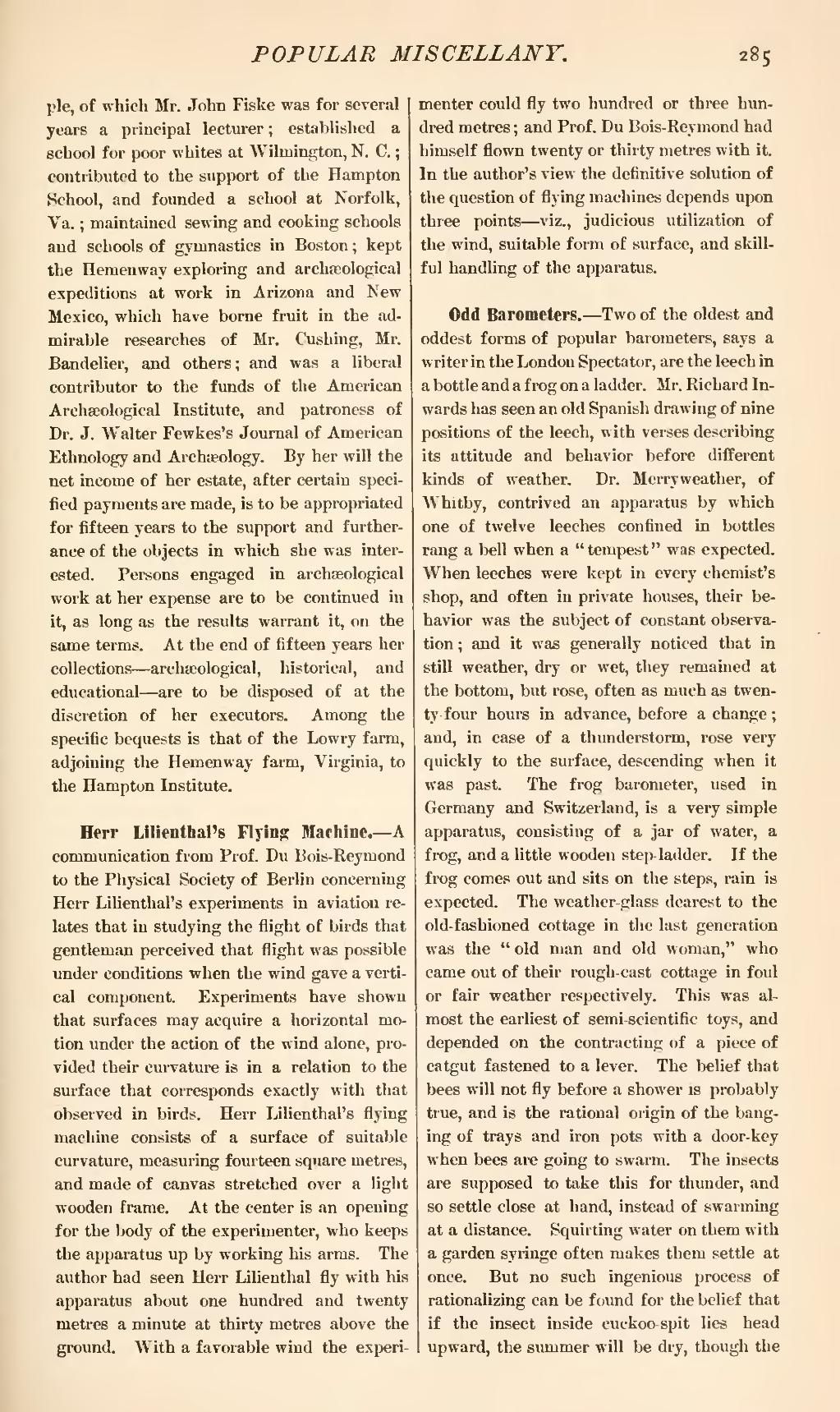ple, of which Mr. John Fiske was for several years a principal lecturer; established a school for poor whites at Wilmington, N. C.; contributed to the support of the Hampton School, and founded a school at Norfolk, Va.; maintained sewing and cooking schools and schools of gymnastics in Boston; kept the Hemenway exploring and archæological expeditions at work in Arizona and New Mexico, which have borne fruit in the admirable researches of Mr. Gushing, Mr. Bandelier, and others; and was a liberal contributor to the funds of the American Archaeological Institute, and patroness of Dr. J. Walter Fewkes's Journal of American Ethnology and Archæology. By her will the net income of her estate, after certain specified payments are made, is to be appropriated for fifteen years to the support and furtherance of the objects in which she was interested. Persons engaged in archæological work at her expense are to be continued in it, as long as the results warrant it, on the same terms. At the end of fifteen years her collections—archæological, historical, and educational—are to be disposed of at the discretion of her executors. Among the specific bequests is that of the Lowry farm, adjoining the Hemenway farm, Virginia, to the Hampton Institute.
Herr Lilienthal's Flying Machine.—A communication from Prof. Du Bois-Reymond to the Physical Society of Berlin concerning Herr Lilienthal's experiments in aviation relates that in studying the flight of birds that gentleman perceived that flight was possible under conditions when the wind gave a vertical component. Experiments have shown that surfaces may acquire a horizontal motion under the action of the wind alone, provided their curvature is in a relation to the surface that corresponds exactly with that observed in birds. Herr Lilienthal's flying machine consists of a surface of suitable curvature, measuring fourteen square metres, and made of canvas stretched over a light wooden frame. At the center is an opening for the body of the experimenter, who keeps the apparatus up by working his arms. The author had seen Herr Lilienthal fly with his apparatus about one hundred and twenty metres a minute at thirty metres above the ground. With a favorable wind the experimenter could fly two hundred or three hundred metres; and Prof. Du Bois-Reymond had himself flown twenty or thirty metres with it. In the author's view the definitive solution of the question of flying machines depends upon three points—viz., judicious utilization of the wind, suitable form of surface, and skillful handling of the apparatus.
Odd Barometers.—Two of the oldest and oddest forms of popular barometers, says a writer in the London Spectator, are the leech in a bottle and a frog on a ladder. Mr. Richard Inwards has seen an old Spanish drawing of nine positions of the leech, with verses describing its attitude and behavior before different kinds of weather. Dr. Merryweather, of Whitby, contrived an apparatus by which one of twelve leeches confined in bottles rang a bell when a "tempest" was expected. When leeches were kept in every chemist's shop, and often in private houses, their behavior was the subject of constant observation; and it was generally noticed that in still weather, dry or wet, they remained at the bottom, but rose, often as much as twenty-four hours in advance, before a change; and, in case of a thunderstorm, rose very quickly to the surface, descending when it was past. The frog barometer, used in Germany and Switzerland, is a very simple apparatus, consisting of a jar of water, a frog, and a little wooden step-ladder. If the frog comes out and sits on the steps, rain is expected. The weather-glass dearest to the old-fashioned cottage in the last generation was the "old man and old woman," who came out of their rough-cast cottage in foul or fair weather respectively. This was almost the earliest of semi-scientific toys, and depended on the contracting of a piece of catgut fastened to a lever. The belief that bees will not fly before a shower is probably true, and is the rational origin of the banging of trays and iron pots with a door-key when bees are going to swarm. The insects are supposed to take this for thunder, and so settle close at hand, instead of swarming at a distance. Squirting water on them with a garden syringe often makes them settle at once. But no such ingenious process of rationalizing can be found for the belief that if the insect inside cuckoo-spit lies head upward, the summer will be dry, though the

